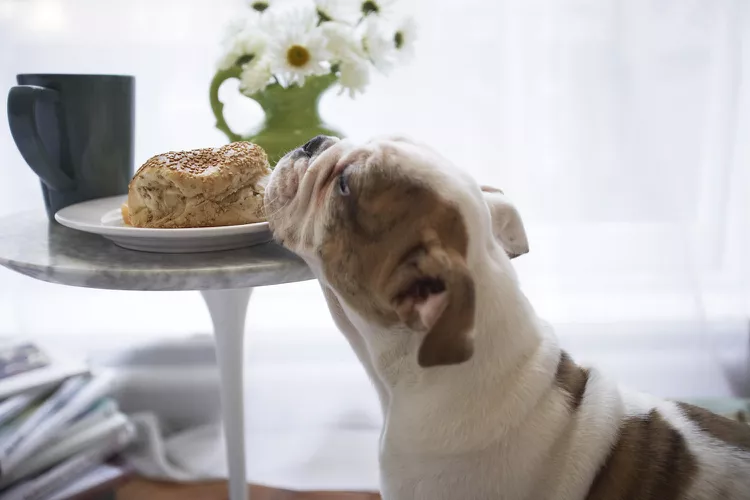Can Dogs Eat Bread?

If you were to raid the pantry of your average American kitchen, you would in all likelihood find a loaf or two of bread. Between breakfast toast, sandwiches for lunch, and sides of garlic bread with dinner, bread is an incredibly versatile comfort food. With its prevalence in American homes, you may be tempted to sneak a piece to your pup, but is that okay? Is bread safe for your dog to nibble on?
The short answer is yes, unless your dog has an underlying wheat allergy, your average, store-bought or home made white or wheat bread is safe for your pooch. That doesn't mean it's the healthiest snack, though. There are also varieties of bread that you should definitely stay away from as there are things food companies will add to bread that are themselves not safe for your dog to eat.
The Dangers of a High-Bread Diet
Unfortunately, just as with people, a diet that is high in bread can make your dog more prone to obesity. Additionally, due to its high glycemic index, bread can make a diabetic dog's blood sugar spike. If your diabetic dog repeatedly is getting into bread it can make it difficult to keep your pup's diabetes controlled.
Most folks will nibble on plain, dry toast when they are feeling a little under the weather. When your vet recommends a bland diet for your dog's stomach troubles this may be what first comes to mind. However, plain white or brown rice and boiled chicken is far healthier than a helping of bread. Chicken and rice has more of what your dog needs to recover from their stomach bug and less of what they don't.
Concerns About Dough
There really is nothing like fresh, crusty, homemade bread. While a bite of the finished product might be okay for your pup to enjoy, the unbaked bread dough can be deadly. The active yeast in the dough will continue to make the dough rise. This is cause your poor dog's stomach to distend, mimicking or even causing bloat, a deadly condition in which the stomach distends and then twists on itself. If you suspect your dog has bloat seek immediate veterinary attention. When the stomach twists on itself the blood supply is cut off, which can lead to tissue necrosis (tissue death) followed by septicemia (blood poisoning).
Unfortunately, a bloat risk from active yeast cultures isn't the worst thing that can happen from bead dough ingestion. The yeast in the bread dough can also release ethanol into your dog's blood stream, causing alcohol toxicity. The onset of symptoms can be between 30 and 60 minutes after ingestion and requires immediate veterinary attention. Left untreated, it can lead to coma and death.
Bread Varieties to Avoid
Cinnamon raisin bread be delicious for breakfast toast but raisins can be dangerous for your dog. Raisins (and grapes) can cause acute kidney failure in dogs. Some dogs are more susceptible to raisins and grapes than others but veterinary researches don't fully understand why, so if your dog gets into any raisin bread call your vet immediately. Always keep raisin bread out of reach of your dog and never give your dog raisin bread to snack on, even if there aren't any raisins in the piece that you give them.
Garlic, in large amounts, can also be harmful to dogs. If your pup got into garlic toast they may suffer from gastrointestinal upset such as vomiting and diarrhea, as well as anemia.
Seeded breads and bagels as well as nut breads have become more and more popular the past several years. The biggest nut you should be aware of are macadamia nuts. These are toxic to dogs, causing vomiting, fever, muscle tremors, and weakness. What about other seed breads? Seeds and nuts that aren't actually toxic to dogs may still cause stomach irritation and pancreatitis. Dogs aren't meant to eat whole nuts and seeds on a regular basis and trying to digest them can be taxing on your dog's GI tract.
Another ingredient to be cognizant about is xylitol. An artificial sweetener, it can be found most commonly in sugar-free gum and can cause a dangerous drop in your dog's blood sugar or even injury to the liver if it eats any. Recently food companies have been adding xylitol to different food stuffs that they want to sweeten without adding sugar. Most noticeably are sweet varieties of peanut butter and bread. Even a seedless, garlic-free, non-raisin, run-of-the-mill white bread may contain xylitol, so always check the ingredients before you share a bite with your dog.
While most sandwich bread is safe for your dog to eat, not all kinds of bread you find at the supermarket will be. There are also healthier treats out there for your pooch to snack on. Your vet can give you more insight about what treats are okay for your dog to eat and what treats you should steer clear of.